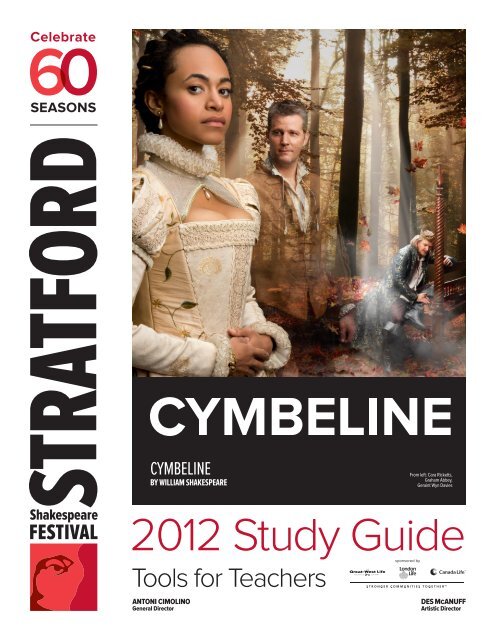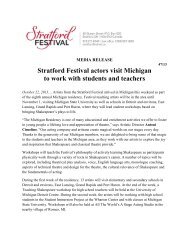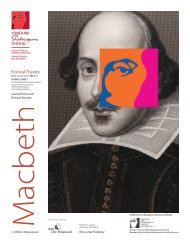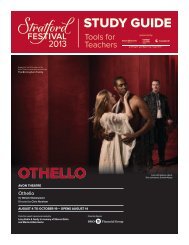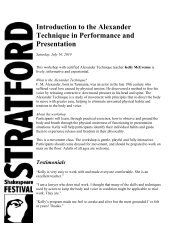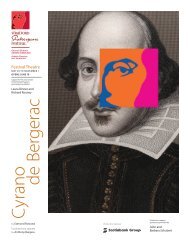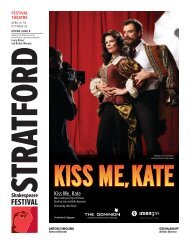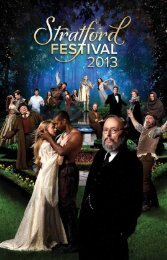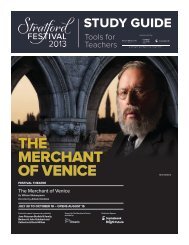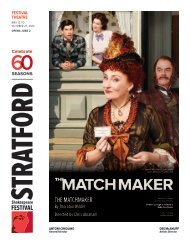2012 Study Guide - Stratford Festival
2012 Study Guide - Stratford Festival
2012 Study Guide - Stratford Festival
You also want an ePaper? Increase the reach of your titles
YUMPU automatically turns print PDFs into web optimized ePapers that Google loves.
The Playwright:William ShakespeareBorn in <strong>Stratford</strong>-upon-Avon, a smallWarwickshire town, in 1564, WilliamShakespeare was the eldest son of JohnShakespeare, a glover, and Mary Arden, thedaughter of a wealthy farmer. The exact dateof his birth is unknown, but baptismal recordspoint to it being the same as that of his death,April 23. He probably attended what is now theEdward VI Grammar School, where he wouldhave studied Latin literature, and at 18, hemarried a farmer’s daughter, Anne Hathaway,with whom he had three children: Susanna,born in 1583, and, two years later, the twinsHamnet (who died in childhood) and Judith.1623, fellow dramatist Ben Jonson called him aman “not of an age, but for all time”. Not onlydid Shakespeare write some of the mostpopular plays of all time, but he was a veryprolific writer, writing 38 (canonically accepted)works in 23 years. His work covered manysubjects and styles, including comedies,tragedies, histories and romances, all bearinghis hallmark expansive plots, extraordinarylanguage and humanist themes. Shakespeareenjoyed great popularity in his lifetime, and400 years later, he is still the most producedplaywright in the world.Nothing further is known of his life until 1592,when his earliest known play, the first part ofHenry VI, became a hit in London, whereShakespeare was now working as an actor.Soon afterwards, an outbreak of the plagueforced the temporary closure of the theatres,and Shakespeare turned for a while to writingpoetry. By 1594, however, he was back in thetheatre, acting with the Lord Chamberlain’sMen. He quickly established himself as one ofLondon’s most successful dramatists, with anincome that enabled him, in 1597, to buy amansion back in <strong>Stratford</strong>. In 1599 he becamea shareholder in London’s newly built GlobeTheatre.In 1603, Shakespeare’s company was awardeda royal patent, becoming known as the King’sMen. Possibly as early as 1610, the playwrightretired to his home in <strong>Stratford</strong>-upon-Avon,living there – and continuing to invest in realestate – until his death on April 23, 1616. He isburied in the town’s Holy Trinity Church.In the first collected edition of his works inCymbeline STUDY GUIDE<strong>Stratford</strong> Shakespeare <strong>Festival</strong> <strong>2012</strong>3
A Shakespearean Timeline1558 Elizabeth I crowned.1564 William Shakespeare born.1572 Actors not under the protection of a patron declared rogues and vagabonds.1576 “The Theatre,” the first public playhouse in London, opens.1577 “The Curtain,” London’s second playhouse, opens.1578 James VI (later James I of England) takes over government of Scotland.1579 Publication of North’s English translation of Plutarch’s Lives of the Noble Greciansand Romans.1580 Francis Drake returns in triumph form his voyage around the world; travellingplayers perform at <strong>Stratford</strong>.1582 Shakespeare marries Anne Hathaway; Susanna is born six months later and thetwins Hamnet and Judith in 1585.1587 “The Rose” theatre opens in London. Mary Queen of Scots is executed.1588 Spanish Armada defeated.1589 Shakespeare finds work as an actor in London; he lives apart from his wife for 21years.1590-1591 The Two Gentlemen of Verona, The Taming of the Shrew.1591 2 Henry VI, 3 Henry VI.1592 Thousands die of plague in London; theatres closed. 1 Henry VI, Titus Andronicus,Richard III.1593 The Comedy of Errors.1594 Shakespeare becomes a shareholder of his theatre company, the LordChamberlain’s Men.1594 Love’s Labour’s Lost.1595 Richard II, Romeo and Juliet, A Midsummer Night’s Dream.1596 Shakespeare’s son, Hamnet, dies.1596-1597 King John, The Merchant of Venice, 1 Henry IV.1597-1598 The Merry Wives of Windsor, 2 Henry IV, Much Ado About Nothing.1598 “The Globe” theatre built.1598-1599 Henry V, Julius Caesar.1599-1600 As You Like It.Cymbeline STUDY GUIDE<strong>Stratford</strong> Shakespeare <strong>Festival</strong> <strong>2012</strong>4
1600-1601Hamlet, Twelfth Night.1601 Shakespeare’s patron arrested for treason following the Essex rebellion; he islater pardoned.1602 Troilus and Cressida.1603 Queen Elizabeth dies and is succeeded by James I; Shakespeare’s theatrecompany becomes the King’s Men.1603 Measure for Measure, Othello.1604 Work begins on the King James Bible.1604-1605 All’s Well That Ends Well, Timon of Athens, King Lear (Q)1606 Macbeth, Antony and Cleopatra.1607 Pericles.1608 Coriolanus.1609 The Winter’s Tale.1610 King Lear (F), Cymbeline.1610 Shakespeare retires to <strong>Stratford</strong>-upon-Avon.1611 The Tempest.1611 King James Bible published.1613 Henry VIII (All Is True), The Two Noble Kinsmen.1613 “The Globe” theatre burns down.1616 Shakespeare dies in <strong>Stratford</strong>-upon-Avon.1623 The first folio of Shakespeare’s collected plays is published.* Some dates are approximate.Cymbeline STUDY GUIDE<strong>Stratford</strong> Shakespeare <strong>Festival</strong> <strong>2012</strong>5
Cast of CharactersCYMBELINE, King of BritainIMOGEN, his daughter by a former queen, later disguised as FideleQUEEN, his second wifeCLOTEN, her son, Cymbeline’s stepsonPOSTHUMUS Leonatus, husband to ImogenPISANIO, his servantCORNELIUS, a doctorLADY, attendant on Imogen, named HelenTwo Lords, attendant on ClotenTwo GentlemenTwo British CaptainsTwo JailersBELARIUS, a banished lord, living in Wales under the name of MorganGUIDERIUS Cymbeline’s sons, known as sons of BelariusARVIRAGUS called Polydore and CadwalPHILARIO, an Italian, Posthumus’s host in RomeIACHIMO, an Italian nobleman, friend of PhilarioA FrenchmanA DutchmanA SpaniardCAIUS LUCIUS, general of the Roman ArmySoothsayer, named PhilarmonusTwo Roman SenatorsA Roman TribuneA Roman CaptainJUPITERGhost of SICILIUS LEONATUS, Posthumus’s fatherGhost of Posthumus’s motherGhosts of Posthumus’s two brothersLords, Attendants, Messengers, Musicians, Roman Tribunes, British and Roman Captains,SoldiersCymbeline STUDY GUIDE<strong>Stratford</strong> Shakespeare <strong>Festival</strong> <strong>2012</strong>6
Plot SynopsisIn the court of Cymbeline, King of Britain, Princess Imogen has secretly married her childhoodsweetheart, Posthumus. The king and his Queen (Imogen’s wicked stepmother) are furiousbecause Posthumus is a commoner and the Queen was hoping to force Imogen into marriagewith her loutish son, Cloten. Banished by the king, Posthumus seeks refuge in Italy, where hemeets the wily Iachimo who succeeds in drawing Posthumus into a wager regarding Imogen’sfidelity. Iachimo sets off to Britain to prove he can seduce Imogen and win the bet. Imogenrejects all of Iachimo’s advances but upon his return to Italy the crafty Italian manages toconvince Posthumus that Imogen has, in fact, been unfaithful.Posthumus sends a letter to his servant, Pisanio, who is watching over Imogen at court,instructing him to bring Imogen to Milford-Haven (in Wales) where she will be reunited with herhusband. Little does Imogen know that Pisanio has been instructed to kill her once they arrivethere for her supposed infidelity. Arriving at Milford-Haven, Pisanio cannot and will not kill her.Pisanio reveals Posthumus’s plot and leaves Imogen with some boys’ clothes to disguise herselfand a vial of poison given to him by the Queen (who told him it had healing properties). Imogen,in disguise, gives herself the name “Fidele” and wanders, cold, hungry and exhausted, in thewoods until she happens upon a cave. It turns out that the cave is inhabited by Belarius (anobleman who was, long ago, unjustly banished by Cymbeline) and his two sons, <strong>Guide</strong>rius andArviragus (who, unbeknownst to them, are really Cymbeline’s sons stolen at birth. Belariuskidnapped them in revenge for his banishment). The men feel an instant fondness for “Fidele”and take “him” in.Back at court, Cymbeline refuses to pay the customary tribute to Rome; Caesar declares war onBritain. Cloten decides to take revenge on Imogen for rejecting him in favour of Posthumus and,dressed in Posthumus’s clothes, sets of to Milford-Haven in pursuit of her. Getting lost in thewoods along the way, Cloten encounters Belarius and the two boys, who are out hunting. Clotenpicks a fight with <strong>Guide</strong>rius and ends up, literally, losing his head. Bearing Cloten’s headlessbody, Belarius and the boys return to their cave only to find “Fidele” dead (Imogen has taken theQueen’s potion and has fallen into a death-like sleep). Sadly, the brothers lay “Fidele’s” bodynext to Cloten’s (who is still wearing Posthumus’s clothes). Imogen ultimately awakes to find theheadless body, whom she believes to be Posthumus, beside her. In this moment of despair aRoman soldier, Lucius, happens upon her and takes “Fidele” into his service as a page. As wordof the war spreads, Posthumus (remorseful over having “killed” his wife, and disguised as aBritish peasant), <strong>Guide</strong>rius, Arviragus and Belarius join up to fight against Rome in Britain’sdefence.Against all odds, Britain wins the war. When the Roman prisoners, including Lucius, Fidele andIachimo, are brought before Cymbeline, the revelations and surprises come fast and furiously.Iachimo confesses his lies regarding Imogen; Imogen and Posthumus reveal their identities andare reunited; the doctor announces the Queen’s death and treachery; Belarius reveals hisidentity and that of his “sons” and the whole royal family is happily reunited. Cymbeline makespeace with Rome and pays the tribute due to Caesar.Cymbeline STUDY GUIDE<strong>Stratford</strong> Shakespeare <strong>Festival</strong> <strong>2012</strong>7
Sources and OriginsShakespeare drew on two main sources for the plot of Cymbeline: a translation of a Dutch story,Frederyke of Jennen, published in Antwerp in 1518, and Giovanni Boccaccio’s Decameron (1353).Shakespeare likely read the latter in a popular French translation written by Antoine Le Maçon in1545. The main plot – a man wagering on his wife’s fidelity – had been a popular story forcenturies.Shakespeare also drew on Holinshed’s Chronicles of England, Scotland and Ireland (1587) fordetails of the historical Cunobelinus’s reign. Other historical information came from RobertFabyan’s New Chronicle of England and of France (1516) and A Mirror for Magistrates (1587), acollection of biographies by John Higgins and Thomas Blenerhasset.Such plot lines as Posthumus and Imogen’s love, Cloten’s jealousy, Posthumus’s exile andImogen’s flight come from an anonymous play called The Rare Triumphs of Love and Fortune,performed in 1582 and published in 1589.Historical BackgroundOf all the characters in the play, only Cymbeline and his two sons, <strong>Guide</strong>rius and Arviragus,actually existed. Little is known about the historical Cymbeline (more properly known asCunobelinus), who ruled southeast England for some 35 years in the first century BC.The historical sources available to Shakespeare were contradictory in their accounts, and his titlecharacter bears little relation to what we know of the historical figure. The Roman invasion thatShakespeare depicts Cymbeline resisting, for instance, did not in fact take place till after the realCunobelinus’s death.<strong>Stratford</strong> ProductionHistoryThis is the fourth production of Cymbeline at the <strong>Stratford</strong> Shakespeare <strong>Festival</strong> and the secondto be presented at the Tom Patterson Theatre.Cymbeline STUDY GUIDE<strong>Stratford</strong> Shakespeare <strong>Festival</strong> <strong>2012</strong>8
Cymbeline STUDY GUIDE<strong>Stratford</strong> Shakespeare <strong>Festival</strong> <strong>2012</strong>9
Cymbeline STUDY GUIDE<strong>Stratford</strong> Shakespeare <strong>Festival</strong> <strong>2012</strong>10
Cymbeline STUDY GUIDE<strong>Stratford</strong> Shakespeare <strong>Festival</strong> <strong>2012</strong>11
Cymbeline STUDY GUIDE<strong>Stratford</strong> Shakespeare <strong>Festival</strong> <strong>2012</strong>12
Creative Team<strong>2012</strong> <strong>Stratford</strong> Shakespeare <strong>Festival</strong> ProductionTom Patterson Theatre, May 10 to September 30Director ...................................... Antoni CimolinoSet Designer .............................. Scott PennerCostume Designer ..................... Carolyn M. SmithLighting Designer....................... Robert ThomsonComposer .................................. Steven PageSound Designer ......................... Todd CharltonCymbeline STUDY GUIDE<strong>Stratford</strong> Shakespeare <strong>Festival</strong> <strong>2012</strong>13
The Paparazzi and theTabloidsGrade Level(s) 9-10Subject Area(s) English (and Media Studies), Drama, Media Arts, Visual ArtsCurriculum By the end of the lesson students will be able to:Expectations& Clarify and deepen their conceptual understanding by identifyingthe most important ideas and details;LearningEnglishOutcomes (Oral): 1.6, 1.9, 2.1 (Reading & Literature Studies): 1.3Media Studies: 2.1Drama: B2.2 Make connections between the ideas in the play, utilizing modernconventions and techniques to create meaning;English (Writing): 2.1Media Studies: 3.4Drama: A1.2Media Arts: B2.3Visual Arts: A2.2 Understand the nature and purpose of certain types of media tocommunicate ideas, information and messages.English (Reading & Literature Studies): 2.2Media Studies: 2.2Visual Arts: B2.2Time Needed 3 to 4 class periodsSpaceMaterialsDesks in groups, then open space for presentations/performancesScript, paper, pens, pencils, art/media supplies as needed, computers,film/video equipment as neededSetting Up the Activity:(Prior to Reading the Play) Have the class listen to a song about the paparazzi.Some suggestions:o The Cranberries’ “Paparazzi on Mopeds” (a song about Lady Diana’s death)o Avril Lavigne’s “Take It”o Lady Gaga’s “Paparazzi” (warning: some strong language)Cymbeline STUDY GUIDE<strong>Stratford</strong> Shakespeare <strong>Festival</strong> <strong>2012</strong>14
Class discussion:o What/Who are the paparazzi?o What purpose do they serve?o Why is the public fascinated by knowing everything there is to know (and more!)about stars and royalty?o Do the paparazzi present the truth, a distortion of the truth, or completelyfabricate the facts? Do we care either way? Why?o Discuss the similarities and differences among the following:• Tabloids• Supermarket tabloids• “Yellow” press or journalism (for a brief but good description of the termand its origins go to www.pbs.org/crucible/frames/_journalism.htm)o What attracts certain people to read or view sensational news, allegations,gossip, altered photos and other aggressive tactics employed by the tabloidsand paparazzi?The Activity: Read the opening scene of the play, Act I, scene 1. Look at the two gentlemen discussing the plot developments that have taken place priorto the start of the play. Brainstorm modern-day correlations (eg. Prince William marryingKate Middleton, a commoner). How did the media and public react? Divide the class into four or five groups. Each group will cut the text, keeping what itfeels best summarizes the important details.Developing the Paparazzi/Tabloids:English and Drama Students will perform this as a paparazzi event, tabloid spoof or some sort of skit (eg.people standing at a checkout line in a supermarket, gossiping and reading the tabloids,etc.). Be as creative as you want and ensure everyone in the group is assigned a specificduty and/or role to play.Media Arts Students will create a TV news special (utilizing paparazzi techniques) and mayincorporate photos or live action interviews to illustrate the opening plot developments.Media Studies Students will select a media form to suit the scene (eg. they may choose to create ahomepage of a “Royal Gossip” website, with visuals, or they may create a TVdocumentary with voice-over narration to dramatize the story).Visual Arts Students will storyboard this and create a series of “sensational” tabloid cartoons, usinglines from the script to illustrate the opening plot developments.Cymbeline STUDY GUIDE<strong>Stratford</strong> Shakespeare <strong>Festival</strong> <strong>2012</strong>15
Extensions:(To be done after completing each act or the entire play.)DramaIn groups, title or “caption” each scene and then perform it as a tableau, capturing thegiven mood and action.EnglishTitle or “caption” each scene which reflects both mood and action and has relevance tothe text.Design newspaper headlines and write corresponding articles for each scene. [NOTE:Each student will be assigned a scene (there are 25 scenes in total in the play) and willdesign a newspaper headline and write an article about the scene.]Media Arts Students will work in groups and each group will be assigned a particular scene. Theywill script their scene, utilizing some sort of journalistic format (e.g. televised mainstreamnews, a talk show, paparazzi/tabloid news, etc.). Each group presentation musthave a title or caption for their scene.Media Studies Working in groups, students will create short advertisements that encapsulate the moodand action of each scene. They must create a caption or tag line for their scene ad.Visual Arts Each student will be assigned a scene and design a tabloid poster or picture that clearlyidentifies the subject of the scene, establishes the poster/picture’s relevance to thescene and has a caption that provides context for the poster/picture.Cymbeline STUDY GUIDE<strong>Stratford</strong> Shakespeare <strong>Festival</strong> <strong>2012</strong>16
Symbols, Emblems andStar SignsGrade Level(s) 9-10Subject Area(s) English, Drama, Media ArtsCurriculum By the end of the lesson students will be able to:Expectations& Make connections between the ideas in the play with thedevelopment of Shakespeare’s characters;LearningEnglishOutcomes (Oral Communication): 1.6, 2.1 (Reading & Literature Studies): 1.5, 1.8 (Writing): 1.2, 2.1Drama: A1.2, B3.1Media Arts: A3.1 Demonstrate imaginative, creative and reflective abilities byarticulating character insights through the use of design elements;English (Oral Communication): 1.5, 1.9 (Reading & Literature Studies): 1.6, 2.3 (Writing): 4.2Drama: C1.1Media Arts: B3.3, C3.4 Synthesize and communicate their findings.English (Oral Communication): 1.1 (Reading & Literature Studies): 2.2 (Writing): 1.4Drama: B1.2Media Arts: B2.1Time Needed 4 to 5 class periodsSpaceDesks in groups, then open space for presentations/performancesMaterialsScript, paper, pens, pencils, computers, film/video equipment as neededSetting Up the Activity: Discuss, as a class, the various forms of representation and its uses of the following:o Symbol*: a thing that represents or stands for something else, especially amaterial object representing something abstract.o Emblem*: a heraldic device or symbolic badge of a nation, organization, orfamily; a thing serving as a symbol of a particular quality or concept.Cymbeline STUDY GUIDE<strong>Stratford</strong> Shakespeare <strong>Festival</strong> <strong>2012</strong>17
o Star sign and Horoscope*: a forecast of a person’s future, typically including adelineation of character and circumstances, based on the relative positions ofthe stars and planets at the time of that person’s birth.* = oxforddictionaries.com/definitionThe Activity:Part IAt the start of the play, assign each student (or groups of students) one of the majorcharacters of the play. They will be responsible for tracking that character’s developmentthroughout the play.Each student or group will create an emblematic gesture (or drawing, picture, computergeneratedimage, etc.) and slogan for their assigned character and present this to theclass. [NOTE: This can be done once or on a continual basis, after the completion of eachact, or a shift in plot development, so the students can chart the progression/changes oftheir character.]At the end of the play have the students revisit all their emblematic gestures and slogansand present them to the class. They may choose to add one final emblematic gestureand slogan that best encapsulates the essence of that character.For discussion and/or assessment:o Did the emblematic gestures/drawings and slogans, suit or clearly depict thecharacter?o Did the student or group’s presentation select an emblem that supported thatcharacter’s journey?o Were the slogans relevant to the character, accurate and complete?o Did the student(s) use evocative phrases or expressions that clearly depictedthat character?o Did examining other students’ work on their characters alter their own ideasabout that character?o Were the uses of emblematic gestures or drawings an effective technique toconvey the essence of that character?o Are there similar instances today where a person or prominent figure can bereadily identified by some sort of symbol or gesture? Give examples. Why arethey effective?Part IIThis next step engages the students in dramatic and physical exploration of character throughdrama exercises.Begin with the students in a circle to establish focus and concentration.The students, by now, will be familiar with their assigned character and may choose towear an emblem that signifies their character or continue with their emblematic gesturesas they walk around the room.Each student will secretly choose one person that their character wishes to be close to(Target A) in the play and another person that their character wishes to avoid in the play(Target B). They are not to tell or telegraph their two choices to anyone in the room.The students will begin to walk around the room, trying to go as close to their Target Awhile at the same time avoiding their Target B.Cymbeline STUDY GUIDE<strong>Stratford</strong> Shakespeare <strong>Festival</strong> <strong>2012</strong>18
Allow this to play out for a little while, observing the dynamic shifts (i.e., rhythms andtempi) as the students make discoveries about their character and others.You may choose to have them stop and secretly select a new set of Target A and Bbefore repeating this activity.After a while, have the class reassemble to discuss their observations on this activity.o Did they notice something new about their character?o Was there a heightened sense of urgency on their part when they were pursuingand being pursued?o Did having more than one Target A and B add a new layer of awareness in theirjourney?Part IIIThe students will determine their character’s horoscope or star sign (NOTE: You may alsochoose to incorporate the Chinese Zodiac.)English and Media Arts They will create/design a Facebook page or website for their astrological sign with adescription of their character incorporating relevant quotes and developments from theplay.DramaStudents will create dramatic skits or tableaux about their astrological character,incorporating relevant quotes and developments from the play.Assessment:Things to consider when assessing the horoscope Facebook page, website, or dramaticpresentation: Provides evidence of the language used by the character in the text; Provides evidence of understanding the issues/problems affecting the character; Accurately and appropriately represents the character through symbolic means that bestillustrates the character; Reveals some previously unknown facet of the character, demonstrating a deeperunderstanding of the character.Cymbeline STUDY GUIDE<strong>Stratford</strong> Shakespeare <strong>Festival</strong> <strong>2012</strong>19
Discussion Topics for YourClassFor classes reading the play before seeing it:1. What do you expect to see on stage at the <strong>Stratford</strong> Shakespeare <strong>Festival</strong>? Have each studentmake a list of predictions about what they expect. Save these predictions. After your <strong>Stratford</strong>trip, revisit them to see how they compared to the actual production.2. Create a character web showing how all the characters are connected to each other. Discussthe complexity of these relationships and how they affect the progression of the play.After your <strong>Stratford</strong> trip:1. Cymbeline has appealed to artists and audiences around the world for 400 years. What do youthink the play’s message is?2. What parts did you respond to most?3. Were there parts you wished were different? How?For more classroom activities, complete with instructions, materials and Ontariocurriculum expectation links, visitstratfordshakespearefestival.com/teachingmaterials.Cymbeline STUDY GUIDE<strong>Stratford</strong> Shakespeare <strong>Festival</strong> <strong>2012</strong>20
ResourcesSHAKESPEARE: HISTORY, CRITICISM and BIOGRAPHYBeckerman, Bernard. Shakespeare and the Globe, 1599-1609. 1962.Bentley, G.E. Shakespeare: A Biographical Handbook. 1951.Boyce, Charles. Shakespeare A to Z. 1990.Brown, Ivor. Shakespeare and the Actors. 1970.Brown, John Russell. Shakespeare and his Theatre. 1993.Burgess, Anthony. Shakespeare. 1970.Campbell, Oscar James, ed. The Reader’s Encyclopedia of Shakespeare. 1966.Dobson, Michael, ed. The Oxford Companion to Shakespeare. 2001.Epstein, Norrie. The Friendly Shakespeare. 1992.Frye, R. M. Shakespeare’s Life and Times: a Pictorial Record. 1968.Gurr, Andrew. The Shakespearean Stage, 1574-1642. 1980.Hodges, C. Walter. Shakespeare and the Players. 1948.Muir, Kenneth and Samuel Schoenbaum, eds. A New Companion to Shakespeare Studies, 1985.Nagler, A. M. Shakespeare’s Stage. 1985.Schoenbaum, Samuel. William Shakespeare: A Documentary Life. 1975.Taylor, Gary. Reinventing Shakespeare. 1989.Thomson, Peter. Shakespeare’s Theatre. 1983.Tillyard, E. M. W. The Elizabethan World Picture. 1943.Wells, Stanley, ed. The Cambridge Companion to Shakespeare Studies. 1986.TEACHING SHAKESPEAREAsimov, Isaac. Asimov’s <strong>Guide</strong> to Shakespeare. New York, 1970.Edens, Walter, et al. Teaching Shakespeare. New Jersey: Princeton UP, 1977.Gibson, Rex. Secondary School Shakespeare. Cambridge: 1990.Gibson, Rex. Stepping into Shakespeare. Cambridge: 2000.Gibson, Rex and Field-Pickering, Janet. Discovering Shakespeare’s Language. Cambridge: 1998.O’Brien, Veronica. Teaching Shakespeare. London, 1982.CYMBELINEGarfield, Leon. Shakespeare Stories. Puffin Books: 1985.Gibson, Rex. Teaching Shakespeare. 1998.Gibson, Rex & Field-Pickering, Janet. Discovering Shakespeare’s Language. Cambridge: 1998.Shakespeare, William. Cymbeline. Arden (Third Series). 2009.Shakespeare, William. Cymbeline. Cambridge School, 2nd Ed. 2005.Shakespeare, William. Cymbeline. Oxford University Press, 2008.Shakespeare, William. Cymbeline. The Royal Shakespeare Company (Random House PublishingGroup). 2011.Cymbeline STUDY GUIDE<strong>Stratford</strong> Shakespeare <strong>Festival</strong> <strong>2012</strong>21
ONLINE RESOURCESBookRags.com Homepage, http://www.bookrags.com/studyguidemuchadoaboutnothing/intro.htmlMr. William Shakespeare and the Internet, shakespeare.palomar.eduSh:in:E Shakespeare in Europe, www.unibas.ch/shineEncyclopaedia Britannica presents: Shakespeare and the Globe: Then and Now,search.eb.com/ShakespeareMIT Shakespeare Homepage: The Complete Works of William Shakespeare, thetech.mit.edu/Shakespeare/Shakespeare’s Life and Times, web.uvic.ca/shakespeare/Library/SLT/intro/introsubj.htmlShakespeare Online, www.shakespeare-online.comMovie Review Query Engline, www.mrqe.comInternet Movie Database, www.imdb.comCYMBELINE ON FILM, VIDEO AND DVD1982 (UK-BBC), Cymbeline. Directed by Elijah Moshinsky; starring Helen Mirren,Michael Pennington, Claire Bloom, and Robert Lindsay.1983 (UK-BBC), Shakespeare in Perspective: Cymbeline. Presented by Dennis Potter.Cymbeline STUDY GUIDE<strong>Stratford</strong> Shakespeare <strong>Festival</strong> <strong>2012</strong>22


